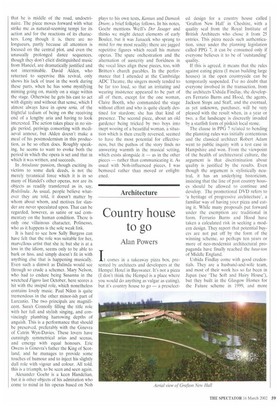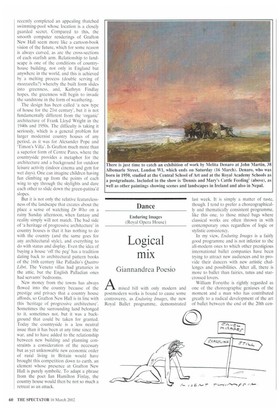Architecture
Country house to go
Alan Powers
It comes in a takeaway pizza box, presented by architects and developers at the Hempel Hotel in Bayswater. It's not a pizza (I don't think the Hempel is a place where you would do anything as vulgar as eating), but it's country house to go — a preselect
ed design for a country house called 'Grafton New Hall' in Cheshire, with a quality seal from the Royal Institute of British Architects who chose it from 25 entries. This pizza needs such authentication, since under the planning legislation called PPG 7, it can be consumed only if everyone believes it to be of 'outstanding' quality.
If this is agreed, it means that the rules against eating pizza (I mean building large houses) in the open countryside can be temporarily suspended. I've no doubt that everyone involved in the transaction, from the architects Ushida Findlay, the developers Ferrario Burns and Hood, the agents, Jackson Stops and Staff, and the eventual, as yet unknown, purchaser, will be very pleased with the result when, in a year or two, a flat landscape is discreetly invaded by a starfish form of pinkish local stone.
The clause in PPG 7 related to bending the planning rules was initially contentious and the classical architect Robert Adam went to public inquiry with a test case in Hampshire and won. From the viewpoint of the health of architectural culture, the argument is that discrimination about quality is justified by the results. Even though the argument is stylistically neutral, it has an underlying historicism, insisting that the line of past country houses should be allowed to continue and develop. The promotional DVD refers to 'a heritage of progressive architecture', a familiar way of having your pizza and eating it. While many proposals put forward under the exemption are traditional in form, Ferrario Burns and Hood have taken a calculated risk in seeking a modern design. They report that potential buyers are not put off by the form of the winning scheme, so perhaps ten years or more of neo-modernist architectural propaganda have finally reached the haut-ton of Middle England.
Ushida Findlay come with good credentials. They are a husband-and-wife team, and most of their work has so far been in Japan (see 'The Soft and Hairy House'), but they built in the Glasgow Homes for the Future scheme in 1999, and more
recently completed an appealing thatched swimming-pool whose location is a closely guarded secret. Compared to this, the smooth computer renderings of Grafton New Hall seem more like a cartoon-book vision of the future, which for some reason is always curved, as are the cross-sections of each starfish arm. Relationship to landscape is one of the conditions of countryhouse building, not only in England but anywhere in the world, and this is achieved by a melting process (double serving of mozzarella?) whereby the built form slides into greenness, and, Kathryn Findlay hopes, the greenness will begin to invade the sandstone in the form of weathering.
The design has been called 'a new type of house for the 21st century', but it is not fundamentally different from the 'organic' architecture of Frank Lloyd Wright in the 1940s and 1950s. The difficulty is taking it seriously, which is a general problem for larger modernist country houses of any period, as it was for Alexander Pope and `Timon's Villa'. Is Grafton much more than a superior form of Centre Pares, where the countryside provides a metaphor for the architecture and a background for outdoor leisure activity (indoor cinema and gym for wet days). One can imagine children having fun climbing up from the points of each wing to spy through the skylights and dare each other to slide down the green-patina'd slopes.
But it is not only the relative featurelessness of the landscape that creates about the place a sense of watching Dr Who on a rainy Sunday afternoon, when fantasy and reality simply will not match. The bad side of 'a heritage of progressive architecture' in country houses is that it has nothing to do with the country (and the same goes for any architectural style), and everything to do with status and display. Even the idea of buying a house 'off the peg' has a tradition dating back to architectural pattern books of the 16th century like Palladio's Quattro Libri. The Veneto villas had granaries in the attic, but the English Palladian ones had servants' bedrooms.
New money from the towns has always flowed into the country because of the prestige and privacy that a country house affords, so Grafton New Hall is in line with this 'heritage of progressive architecture'. Sometimes the surrounding land belonged to it, sometimes not, but it was a background that could be taken for granted. Today the countryside is a less neutral issue than it has been at any time since the war, and to have added to the relationship between new building and planning constraints a consideration of the necessary but as yet unknowable new economic order of rural living in Britain would have brought this competition down to earth, an element whose presence at Grafton New Hall is purely symbolic. To adapt a phrase from the poet Ian Hamilton Finlay, the country house would then be not so much a retreat as an attack.

















































































 Previous page
Previous page